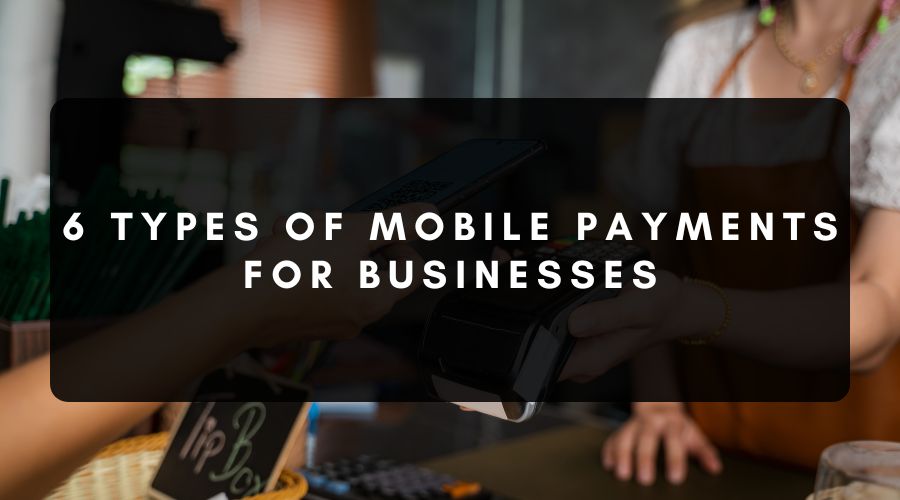
6 Types of Mobile Payments for Business on the Go
Various types of mobile payments are now in popular use and are a great way to streamline transactions and enhance customer convenience in today’s fast-paced business environment. Forward-thinking business owners strive to evolve with customer demand, and offering a range of mobile payment methods will keep you ahead of the curve.
Implementing mobile payment technology is very straightforward for merchants. A payment processor that works with these payment types can also support you to accept mobile payments seamlessly with purpose-built hardware and software.
In-Person Mobile Payment Types
In-person mobile payments include card payments using an mPOS system and contactless payments that involve customers holding their smartphones or other mobile devices near a contactless reader. Contactless mobile payments are typically made using near-field communication payment technology, which facilitates secure data transfer between devices.
1. Mobile POS Systems
Mobile point-of-sale (POS) systems—which typically process payments via the cloud—allow businesses to accept payments wherever they are. Often, a mobile device connected to a card reader is used in place of a traditional POS card reader. This system is perfect for businesses on the go such as tradesmen, food trucks, and salesmen as it allows them to accept card payments without carting bulky hardware around.
Mobile POS systems facilitate instant transactions, preventing small business owners or freelancers from having to rely on cash or cheque payments. This technology can also be a perfect fit for brick-and-mortar businesses that want to process payments “on the floor” rather than at a fixed-location checkout.
How Cloud-Based Payment Systems Work
Cloud-based POS systems allow customers to pay using traditional payment methods like cards or more modern options like pay-by-text and QR codes. Every transaction processed through the same cloud-based merchant account—whether online or in-store—is recorded online and the transaction amounts are automatically aggregated in real time.
Cloud-based POS systems are simple to set up and use. Once your business sets up a merchant services account, you can integrate a global payment gateway and virtual terminal plus install any payment apps that your merchant services provider offers you. You can then use your provider’s virtual terminal, an NFC-enabled mobile device, or an mPOS card reader to process payments.
2. QR Codes
QR code payment technology uses information contained within a barcode-like image to complete secure transactions. Smartphone users can use a QR code app both to make and receive payments. Many modern smartphones, smartwatches, and other devices are equipped with QR technology, making it easy for businesses to accept QR payments and for customers to make them.
QR technology is easy for businesses on the go to set up but, just as with regular credit card payments, it helps to have a merchant services account with an integrated global payment gateway if you plan to accept QR code payments. This is because the merchant must guarantee the security of their customers’ payment information when credit or debit card details are involved.
How QR Code Payments Work
QR payments work in either of the following ways:
- The customer uses a QR code app to scan a QR code provided by the merchant. The customer is then directed to a payment page where they enter their details manually or use a pre-installed payment solution. These include options like Apple Pay, Google Pay, or Samsung Pay.
- The customer can generate a QR code that links to their credit or debit card details or bank account. The merchant then scans the code to complete the transaction through their payment gateway.
Remote Payments
Remote payments are payments that are made without being physically present. Remote payment technology has expanded vastly over the last few decades, giving customers more ways than ever to pay for goods, split bills, or pay back loans.
3. Bank Apps
Mobile bank apps give both customers and merchants access to a wide range of operations. Banking apps allow account holders to generate bank account or transaction-specific QR codes, send and receive ACH/SEPA and wire payments, check the balance of their bank accounts, set transaction limits, and communicate directly with their bank. Many banks require mobile banking customers to have a second app that generates one-time codes for security.
4. Peer-to-Peer Payment Systems
Peer-to-peer (P2P) payments are transactions that occur directly between individuals, without the involvement of a traditional financial institution. There are various ways to make these payments, including:
- Mobile payment apps: Popular mobile payment apps like Venmo and Zelle allow users to send and receive money directly to each other using internet-connected mobile devices.
- Social media platforms: Some social media platforms, such as Facebook and Instagram, have integrated P2P payment features.
P2P payments have become increasingly popular due to their convenience and speed. They are often used for personal transactions, such as splitting bills or paying back friends for loans. In 2019, only 3% of P2P payments were made using a mobile phone (page 25 of the linked PDF). By 2022, this had risen to 10%, showing a jump in popularity in the space of only three years.
5. Pay by Text
Payment by text enables customers to authorise payment via a text message from wherever they are. Payments can be made by text message using inbox-only text payments or payments via a linked URL. Both involve the merchant sending the customer a text message. The subsequent steps in each process are a little different.
Inbox-Only Text Payments
Inbox-only text payments allow customers to make a payment when they receive an SMS on their mobile phone (if they opt in to a company’s text payment service). The process works as follows:
- The merchant sends a text message to the customer when a payment is due. This message may contain information such as:
- The customer’s current or overdue account balance
- A payment reminder
- A payment notification
- The customer will then respond to the message with a term provided in the merchant’s message. For example, “yes,” “no,” or “pay now.”
- If the customer signalled they were ready to pay, the merchant processes the payment through their payment gateway using stored payment information that the customer provided on a previous date.
- The merchant or payment processing application will send the customer a reply text confirming receipt.
Payments via Linked URL
A customer who opts in to a company’s text payment service will receive an invoice with a payment link via SMS:
- When the customer taps on the URL, a simplified checkout page will open.
- The customer enters the details of the payment method they wish to use.
- The merchant’s payment gateway processes the payment before sending the customer a message confirming receipt.
6. Retailer Apps
Some retailer apps are closed-loop mobile payment systems. These apps are specific to a retailer or group of retailers and can be used to make payments, earn rewards, and receive discounts.
Retailer apps are designed to provide a convenient and personalised shopping experience for customers. They typically offer the following features:
- Product browsing and search: Users can easily browse a retailer’s product catalogue and search for specific items with product information.
- Personalised recommendations: Retailers can use customer data to offer personalised product recommendations and promotions.
- Loyalty programs: Many retail apps integrate with loyalty programs, allowing customers to earn points or rewards for their purchases.
- Order tracking: For online orders, customers can track the status of their shipments and returns.
- In-store features: Some retail apps offer in-store features like barcode scanning, mobile checkout, and personalised assistance.
Retailer apps are a valuable tool for businesses to increase sales, improve customer satisfaction, and build brand loyalty. By providing a seamless and convenient shopping experience, retailers can attract and retain more customers.
Meet Customer Expectations with Mobile Payments
Mobile payments have revolutionised the way businesses conduct transactions. Accepting mobile payments is especially important for businesses on the go as they facilitate instant payments and avoid having to deal with cash or cheques.
By understanding mobile payment solutions, businesses can make informed decisions about the best solutions for their and their customers’ needs. Embrace mobile payments to enhance customer satisfaction, streamline operations, and stay ahead of the competition in today’s digital-first world.

